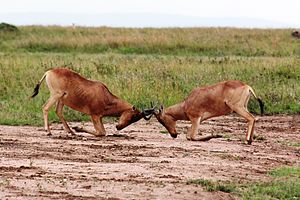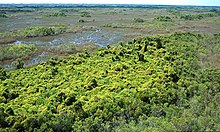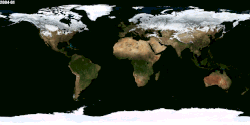Portal:Ecology
| |
|
|
Ecology
|
|
Ecology (from Ancient Greek οἶκος (oîkos) 'house', and -λογία (-logía) 'study of') is the natural science of the relationships among living organisms, including humans, and their physical environment. Ecology considers organisms at the individual, population, community, ecosystem, and biosphere levels. Ecology overlaps with the closely related sciences of biogeography, evolutionary biology, genetics, ethology, and natural history. Ecology is a branch of biology, and is the study of abundance, biomass, and distribution of organisms in the context of the environment. It encompasses life processes, interactions, and adaptations; movement of materials and energy through living communities; successional development of ecosystems; cooperation, competition, and predation within and between species; and patterns of biodiversity and its effect on ecosystem processes. Ecology has practical applications in conservation biology, wetland management, natural resource management (agroecology, agriculture, forestry, agroforestry, fisheries, mining, tourism), urban planning (urban ecology), community health, economics, basic and applied science, and human social interaction (human ecology). The word ecology (German: Ökologie) was coined in 1866 by the German scientist Ernst Haeckel. The science of ecology as we know it today began with a group of American botanists in the 1890s. Evolutionary concepts relating to adaptation and natural selection are cornerstones of modern ecological theory. Ecosystems are dynamically interacting systems of organisms, the communities they make up, and the non-living (abiotic) components of their environment. Ecosystem processes, such as primary production, nutrient cycling, and niche construction, regulate the flux of energy and matter through an environment. Ecosystems have biophysical feedback mechanisms that moderate processes acting on living (biotic) and abiotic components of the planet. Ecosystems sustain life-supporting functions and provide ecosystem services like biomass production (food, fuel, fiber, and medicine), the regulation of climate, global biogeochemical cycles, water filtration, soil formation, erosion control, flood protection, and many other natural features of scientific, historical, economic, or intrinsic value. (Full article...) Selected article - Intraspecific competition is an interaction in population ecology, whereby members of the same species compete for limited resources. This leads to a reduction in fitness for both individuals, but the more fit individual survives and is able to reproduce. By contrast, interspecific competition occurs when members of different species compete for a shared resource. Members of the same species have rather similar requirements for resources, whereas different species have a smaller contested resource overlap, resulting in intraspecific competition generally being a stronger force than interspecific competition. Individuals can compete for food, water, space, light, mates, or any other resource which is required for survival or reproduction. The resource must be limited for competition to occur; if every member of the species can obtain a sufficient amount of every resource then individuals do not compete and the population grows exponentially. Prolonged exponential growth is rare in nature because resources are finite and so not every individual in a population can survive, leading to intraspecific competition for the scarce resources. (Full article...)Selected image - Credit: U.S. Navy Three polar bears approach the USS Honolulu (SSN-718), 280 miles from the North Pole. Polar bears have adapted through the process of evolution to have white fur that matches the white, icy arctic tundra.
General imagesThe following are images from various ecology-related articles on Wikipedia.
Related WikiProjectsThings you can do
Entries here consist of Good and Featured articles, which meet a core set of high editorial standards.
Invasive species in the Everglades are exotic plants and animals that are not native to the area and have aggressively adapted to conditions in wilderness areas in southern Florida. The Everglades are a massive watershed in the southern portion of the U.S. state of Florida that drains overflow from the vast shallow Lake Okeechobee that is in turn fed by the Kissimmee River. The overflow forms a very shallow river about 60 miles (100 km) wide and 100 miles (160 km) long that travels about half a mile per day. The network of ecosystems created by the Everglades are surrounded by urban areas to the east in the South Florida metropolitan area, to the west by Naples and Fort Myers, and to the south by Florida Bay, a marine environment that receives fresh water from and is maintained by the Everglades. As it is surrounded on three sides and close to a major transportation and shipping center, it is particularly vulnerable to the importation of exotic species. In the 20th century, Florida experienced a population surge unparalleled in the U.S., accompanied by rapid urban expansion made possible by draining portions of the Everglades. Flood control became a priority and the Central & South Florida Flood Control Project, from 1947 to 1971, constructed over 1,400 miles (2,300 km) of canals and flood control structures in South Florida. The widespread building created new habitats and disturbed established plant and animal communities. Many of the new residents or tourists in Florida were responsible for introducing plant species to the area by accident, or deliberately to improve landscaping. Many animals have been introduced similarly, and have either escaped or been released to proliferate on their own. Several terms are used to identify non-native species: exotic, invader, immigrant, colonist, introduced, nonindigenous, and naturalized. "Naturalized" usually refers to species that have adapted to a region over a long period of time, while "invasive" refers to particularly destructive or aggressive species. (Full article...)Selected biography -
Aparajita Datta (born 1970) is an Indian wildlife ecologist who works for the Nature Conservation Foundation. Her research in the dense tropical forests of Arunachal Pradesh has successfully focused on hornbills, saving them from poachers. In 2013, she was one of eight conservationists to receive the Whitley Award. She is also a Co-Chair of the IUCN Hornbill Specialist Group. (Full article...)
Did you know (auto-generated)
Selected quote -
Ecology news
Additional News Highlights
Selected publication -Conservation and Society is a peer-reviewed scientific and social science journal, which is published on a quarterly basis. It is interdisciplinary in scope. The editor in chief is Kamaljit Bawa (University of Massachusetts). The journal was established in 2003. Prior to 2005 the frequency of publication was semiannual. (Full article...) Related portalsMore did you know -Related articlesAssociated WikimediaThe following Wikimedia Foundation sister projects provide more on this subject:
Web resources
Discover Wikipedia using portals |

















































